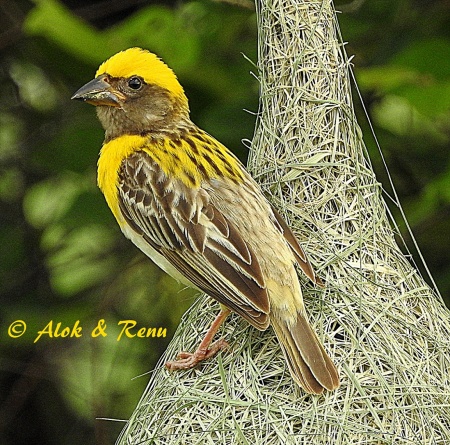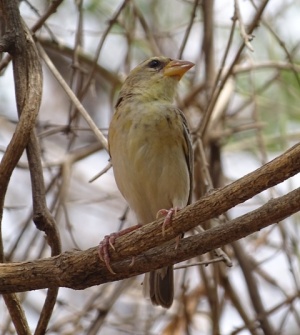
Photo by Alok Tewari
Keoladeo National Park, India, 24 July 2015
- Ploceus philippinus
Identification
15 cm (6 in)
- Short square tail
Breeding males
- Bright yellow crown
- Dark brown mask
- Blackish brown bill
- Upper parts dark brown streaked with yellow
- Yellow breast
- Creamy-buff underparts
Non breeding
- Upperparts dark brown streaked fulvous buff
- Plain whitish-fulvous underparts
- Long buffy eyebrows
- Lacks mask
- Stout horn-coloured conical bill
Distribution
Asia: China, Tibet, Nepal
South Asia: Pakistan, India, Eastern and Western Himalayas, Sri Lanka, Bhutan
Southeast Asia: Indochina, Myanmar], Laos, Vietnam, Cambodia, Thailand, Malaysia, Borneo, Singapore, Indonesia, Greater Sundas, Sumatra, Java and Bali
Taxonomy
Subspecies
There are 5 subspecies[1]:
- P. p. philippinus:
- P. p. travencoreensis:
- South-western India (Goa to Travancore and Kerala)
- P. p. burmanicus:
- North-eastern India (Bengal) to Bangladesh, Assam and Myanmar
- P. p. infortunatus:
- Malay Peninsula to southern Vietnam, Sumatra and Nias Island
- P. p. angelorum:
- Plains of central Thailand
Habitat
Mangroves, reeds, grassland, cultivated areas, scrub and secondary growths usually near fresh or brackish water.
Behaviour
Diet
The diet consists mostly of grass seeds and cultivated rice.
Breeding
Colonial nesters with up to 20-30 pairs, usually in trees near freshwater and open ground. The male builds a basic nest from woven grass which hangs from a palm frond or branch and resembling an upside down flask, which they then display to visiting females. If a female likes the look of the nest and its male she will mate with him before lining the nest herself and laying and incubating the 3-4 white eggs.
Gallery
Click on photo for larger image
Subspecies P. p. infortunatus: Male
Photo © by the late Dr Manjeet Singh
Pondamaran-jaya, Port Klang, Selangor, Malaysia, May 2008
References
- Clements, J. F., P. C. Rasmussen, T. S. Schulenberg, M. J. Iliff, T. A. Fredericks, J. A. Gerbracht, D. Lepage, A. Spencer, S. M. Billerman, B. L. Sullivan, and C. L. Wood. 2023. The eBird/Clements checklist of Birds of the World: v2023. Downloaded from https://www.birds.cornell.edu/clementschecklist/download/
- Avibase
- Handbook of the Birds of the World Alive (retrieved June 2016)
- BBirdForum Member observations
Recommended Citation
- BirdForum Opus contributors. (2025) Baya Weaver. In: BirdForum, the forum for wild birds and birding. Retrieved 17 May 2025 from https://www.birdforum.net/opus/Baya_Weaver
External Links
GSearch checked for 2020 platform.1








